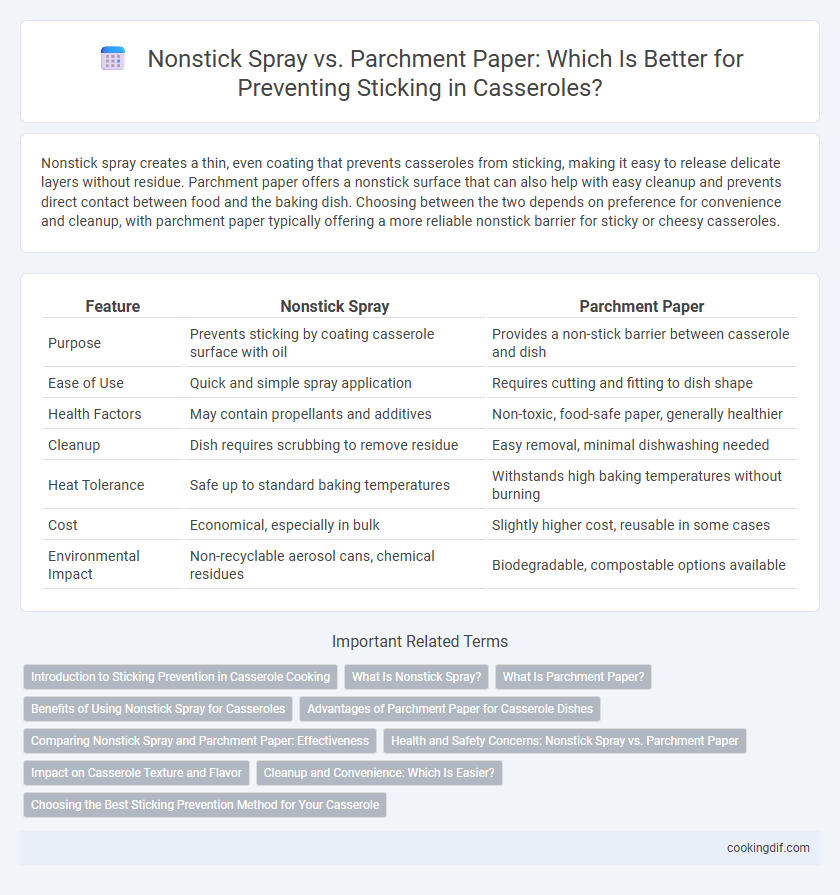Nonstick spray creates a thin, even coating that prevents casseroles from sticking, making it easy to release delicate layers without residue. Parchment paper offers a nonstick surface that can also help with easy cleanup and prevents direct contact between food and the baking dish. Choosing between the two depends on preference for convenience and cleanup, with parchment paper typically offering a more reliable nonstick barrier for sticky or cheesy casseroles.
Table of Comparison
| Feature | Nonstick Spray | Parchment Paper |
|---|---|---|
| Purpose | Prevents sticking by coating casserole surface with oil | Provides a non-stick barrier between casserole and dish |
| Ease of Use | Quick and simple spray application | Requires cutting and fitting to dish shape |
| Health Factors | May contain propellants and additives | Non-toxic, food-safe paper, generally healthier |
| Cleanup | Dish requires scrubbing to remove residue | Easy removal, minimal dishwashing needed |
| Heat Tolerance | Safe up to standard baking temperatures | Withstands high baking temperatures without burning |
| Cost | Economical, especially in bulk | Slightly higher cost, reusable in some cases |
| Environmental Impact | Non-recyclable aerosol cans, chemical residues | Biodegradable, compostable options available |
Introduction to Sticking Prevention in Casserole Cooking
Nonstick spray creates a thin, even coating that effectively prevents casseroles from adhering to baking dishes, ensuring easy release and minimal residue. Parchment paper acts as a physical barrier, providing a reliable nonstick surface ideal for delicate casseroles that might otherwise cling or break apart. Choosing between nonstick spray and parchment paper depends on casserole texture and baking requirements, impacting cleanup and presentation.
What Is Nonstick Spray?
Nonstick spray is a convenient cooking aid composed of oil and lecithin designed to create a thin, even coating on casserole dishes, preventing food from adhering during baking. It offers quick application and easy cleanup, enhancing the browning and texture of casseroles without the need for extra fat. Compared to parchment paper, nonstick spray allows direct contact with the dish surface, ensuring better heat distribution and crispier crusts in casserole recipes.
What Is Parchment Paper?
Parchment paper is a moisture-resistant, non-stick baking sheet made from cellulose fibers treated with silicone, designed to prevent food from sticking to cookware surfaces like casserole dishes. Unlike nonstick spray, parchment paper acts as a physical barrier, making cleanup easier and reducing the risk of altering the taste or texture of casseroles. Its heat-resistant properties allow it to withstand oven temperatures commonly used in baking casseroles, ensuring consistent results without burning or sticking.
Benefits of Using Nonstick Spray for Casseroles
Nonstick spray provides an even, thin coating that prevents casseroles from sticking while enabling easy release, reducing the risk of damage to delicate dishes. Its quick application saves time compared to cutting and fitting parchment paper, particularly for irregularly shaped pans. Nonstick sprays also enhance browning and crisping on casserole edges, improving overall texture and flavor.
Advantages of Parchment Paper for Casserole Dishes
Parchment paper offers superior nonstick properties for casserole dishes by creating a protective barrier that prevents food from adhering to the baking surface, ensuring easy removal and cleanup. Its heat-resistant quality allows it to withstand high oven temperatures without burning or releasing harmful chemicals, unlike some nonstick sprays. Additionally, parchment paper eliminates the risk of uneven coating and potential sogginess caused by sprays, preserving the casserole's texture and presentation.
Comparing Nonstick Spray and Parchment Paper: Effectiveness
Nonstick spray offers a quick and even coating that effectively prevents casseroles from sticking to baking dishes, ensuring easy release and minimal residue. Parchment paper provides a reliable nonstick surface and adds the benefit of easy cleanup, but it may not conform perfectly to all casserole shapes, sometimes allowing edges to stick. Overall, nonstick spray proves more versatile for various casserole types, while parchment paper excels in providing a clean separation with less mess.
Health and Safety Concerns: Nonstick Spray vs. Parchment Paper
Nonstick spray often contains chemicals like propellants and solvents that can release harmful fumes when overheated, posing respiratory risks during casserole baking. Parchment paper, made from silicone-coated or quilled cellulose, offers a safer alternative by preventing sticking without introducing toxic substances or chemical residues. Choosing parchment paper reduces exposure to potentially hazardous compounds, enhancing health and safety in the kitchen.
Impact on Casserole Texture and Flavor
Nonstick spray creates a thin, even coating that prevents casserole ingredients from sticking without altering the dish's texture, maintaining a moist and tender consistency. Parchment paper acts as a physical barrier, reducing direct contact with the baking pan and preserving the casserole's natural flavors, but may slightly affect browning and crispness around edges. Choosing between the two impacts the final casserole texture: nonstick spray favors even browning and moisture retention, while parchment enhances delicate texture preservation but can limit crust development.
Cleanup and Convenience: Which Is Easier?
Nonstick spray creates a thin, even coating that prevents food from sticking to casserole dishes, making cleanup quick and effortless. Parchment paper offers a reusable barrier that catches drips and baked-on residue, simplifying dishwashing but requires extra preparation time. For maximum convenience and minimal cleanup, nonstick spray is generally easier, while parchment paper provides added protection but involves more steps.
Choosing the Best Sticking Prevention Method for Your Casserole
Choosing the best sticking prevention method for your casserole depends on factors such as cooking temperature, recipe type, and cleanup preferences. Nonstick spray offers quick and even coverage, ideal for delicate casseroles or baked goods that require minimal oil. Parchment paper provides a reliable, reusable barrier that prevents sticking while also facilitating easy removal and cleanup, especially for casseroles with gooey or sticky ingredients.
Nonstick spray vs parchment paper for sticking prevention Infographic

 cookingdif.com
cookingdif.com